初中英语人教版七年级下册第五单元写作课教学设计
- 格式:doc
- 大小:22.00 KB
- 文档页数:6

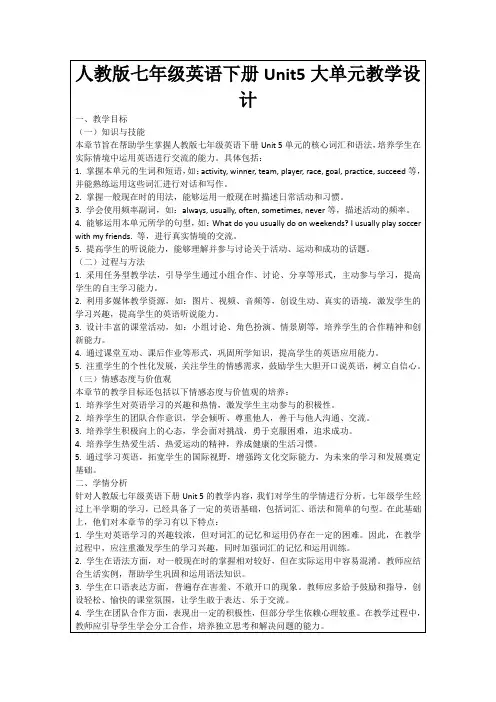
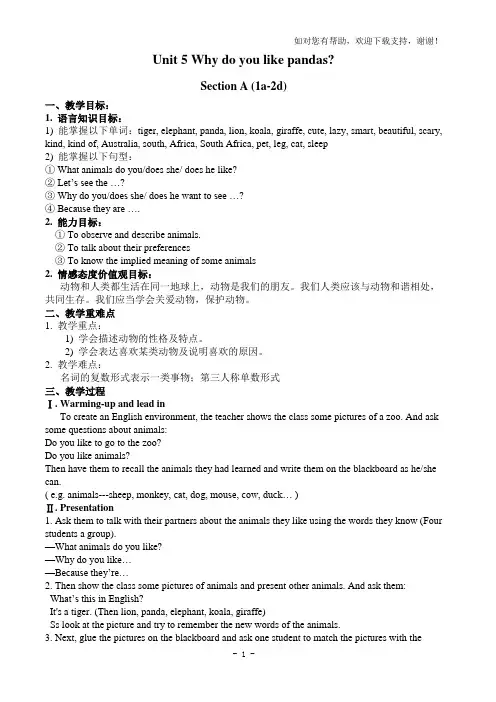
Unit 5 Why do you like pandas?Section A (1a-2d)一、教学目标:1. 语言知识目标:1) 能掌握以下单词:tiger, elephant, panda, lion, koala, giraffe, cute, lazy, smart, beautiful, scary, kind, kind of, Australia, south, Africa, South Africa, pet, leg, cat, sleep2) 能掌握以下句型:① What animals do you/does she/ does he like?②Let’s see the …?③Why do you/does she/ does he want to see …?④Because they are ….2. 能力目标:① To observe and describe animals.② To talk about their preferences③ To know the implied meaning of some animals2. 情感态度价值观目标:动物和人类都生活在同一地球上,动物是我们的朋友。
我们人类应该与动物和谐相处,共同生存。
我们应当学会关爱动物,保护动物。
二、教学重难点1. 教学重点:1) 学会描述动物的性格及特点。
2) 学会表达喜欢某类动物及说明喜欢的原因。
2. 教学难点:名词的复数形式表示一类事物;第三人称单数形式三、教学过程Ⅰ. Warming-up and lead inTo create an English environment, the teacher shows the class some pictures of a zoo. And ask some questions about animals:Do you like to go to the zoo?Do you like animals?Then have them to recall the animals they had learned and write them on the blackboard as he/she can.( e.g. animals---sheep, monkey, cat, dog, mouse, cow, duck… )Ⅱ. Presentation1. Ask them to talk with their partners about the animals they like using the words they know (Four students a group).—What animals do you like?—Why do you like…—Because they’re…2. Then show the class some pictures of animals and present other animals. And ask them: What’s this in English?It's a tiger. (Then lion, panda, elephant, koala, giraffe)Ss look at the picture and try to remember the new words of the animals.3. Next, glue the pictures on the blackboard and ask one student to match the pictures with thewords on the cards. Other students turn to page 25 and finish 1a.4. Check the answers with the class.Ⅲ. Game (Guessing game.)T: Show some pictures on the big screen. Let Ss guess what animal it is.Ss try to guess and remember the names of the animals.Ⅳ. ListeningWork on 1b.Tell Ss to listen to the tape and check the animals they hear in 1a.Play the recording again and check the answers with the class.Ⅴ. Pair work1. Ask th e students to imagine “ We are in the zoo, there are many kinds of animals here.”Then ask a student to do the model with you:—Let’s see the lions first.—Why? (why do you /does she /does he like lions?)—Because they are interesting.2. Ss work with their partners practice the conversation using the animal in 1a.Ⅵ. Listening1. Work on 2a;T: Listen to the conversation carefully. Then write the names of the animals you hear on these lines.Play the recording the first time. Students only listen.Play the recording a second time. This time students write in the names of the animals.Check the answers.Point out the adjectives and countries listed on the right. Ask a student to say the words.Say, Now I will play the recording again. This time draw a line between each animal and the adjective and countries you hear.Play the recording and have students match each animal with an adjective and a country. Correct the answers.2. Work on 2bT: Listen again and complete the conversation with the words in 2a.Play the recording for the Ss to listen and write the answers.Check the answers with the class.Ⅶ. Pair work1. Ask two students to read the conversation in 2b to the class.2. Ss practice the conversation in pairs.3. Then show the transcription on the big screen and practice the other two conversations in 2a.4. Ss practice the conversations in pairs.Ⅷ. Role-play1. Ask Ss to look at the picture in 2d. Then Ss read the conversation in 2d and find the answers to the questions:① Does Peter have a pet?② What can Dingding do?③What pet does Jenny’s mom have?④ Does Jenny like the cat? Why?2. Ss read the conversations and try to find the answers to the questions.Check the answers:Yes, he does.He can walk on two legs. He can dance, too.She has a cat.No, she doesn’t. Because it’s very lazy.3. Ss work in pairs and practice the conversation.4. Let some pairs role-play the conversation.Homework:1. Remember the new words and expressions in this period.2. Role-play the conversation after class.3. Write the animal's names as many as possible in the exercises book.板书设计:Section A (Grammar Focus-3c)一、教学目标:1. 语言知识目标:1) 继续练习运用如何做描述动物及表述自己对动物的喜好。
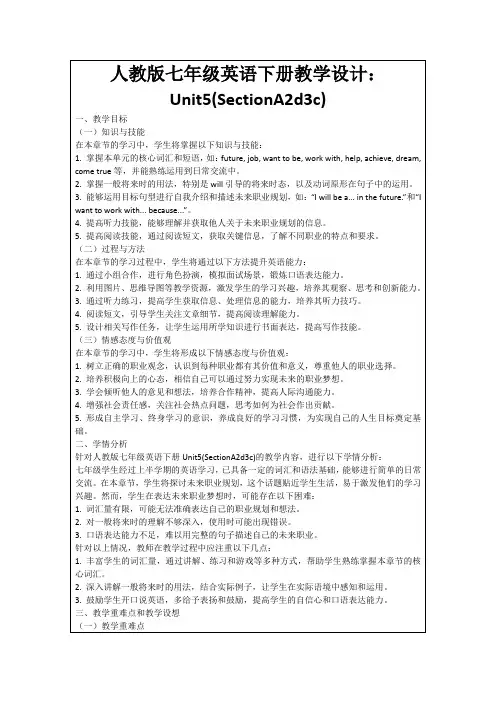

人教版新目标七年级英语下册 Unit 5 教案一. 教材分析人教版新目标七年级英语下册Unit 5主要讲述了日常生活中的一些活动,如游泳、打篮球、跳舞等。
本单元的话题贴近学生的生活,有利于激发学生的学习兴趣。
教材通过听说读写等多种活动,帮助学生掌握日常生活中的交际用语,提高学生的语言运用能力。
二. 学情分析七年级的学生已经掌握了基本的英语语法和单词,对于日常生活中的交际用语也有了一定的了解。
但部分学生可能在发音和口语表达上还存在困难,需要教师在教学中加以引导和纠正。
此外,学生可能对一些体育活动相关的词汇和表达不够熟悉,需要在课堂上进行拓展和练习。
三. 教学目标1.知识目标:学生能够掌握本单元的生词和短语,了解日常生活中的交际用语。
2.能力目标:学生能够听懂、会说、会读、会写与日常生活相关的英语句子。
3.情感目标:学生能够积极参与课堂活动,提高学习英语的兴趣。
四. 教学重难点1.重点:本单元的生词和短语,日常生活中的交际用语。
2.难点:情态动词can的用法,以及与日常生活相关的句型结构。
五. 教学方法1.任务型教学法:通过设置各种任务,让学生在完成任务的过程中学习英语。
2.情景教学法:创设各种生活情境,让学生在真实的环境中学习英语。
3.交际法:鼓励学生积极参与课堂交际,提高口语表达能力。
六. 教学准备1.准备单词卡片、短语卡片、图片等教学辅助材料。
2.准备与本单元话题相关的视频或音频材料。
3.准备课堂练习题和测试题。
七. 教学过程1.导入(5分钟)利用图片或视频引导学生谈论日常生活中喜欢的活动,引出本课话题。
2.呈现(10分钟)老师展示本课的生词和短语,让学生朗读并解释其意思。
同时,老师用情态动词can提问,引导学生回答。
3.操练(15分钟)学生分角色扮演,用情态动词can进行问答。
老师巡回指导,纠正发音和表达错误。
4.巩固(10分钟)学生完成课堂练习题,老师及时批改和讲解。
5.拓展(5分钟)老师引导学生谈论更多关于日常活动的表达,如游泳、打篮球、跳舞等。

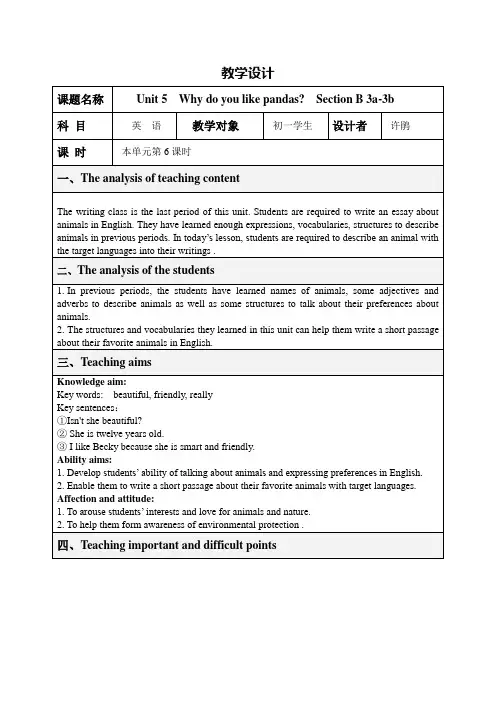
教学设计Step 6 observe and think: (4 mins)Throw questions : Whenwe describe animals, whichinformation can beincluded? What can beconcluded from the twoquestions discussed and 3a?With the help ofteacher, studentsconclude fivebasic aspects todescribe animals.To help students clear theorganize the writingthoughts in English.Step 7 presentation (1 min) Show the writing task: Todescribe your favoriteanimals titled with “Myfavorite animal” .They are ready towrite.To let them understandwhat they are going towrite in this period.Step 8 presentation (1 mins)Have students to reviewthe vocabularies, mainstructures learned aboutanimals description. List allthe information on thescreen.They reviewtarget structuresagain in theirmind.To help them write theshort passage well andmore quickly.Step 9 practice (8 mins) Let students write theiressay within 8 minutes.Choose two students indifferent levels to writetheir samples on theblackboard.Students have tofinish their essaywithin 8 minutes.To practice writing skillswith limited time.Step 10 production (11 mins) Let’s correct together. Theteacher and students worktogether to correct the twosamples on the blackboard.The students lookat the samples onthe blackboardand correct themwith the teacher.1).To realize their ownmistakes in the writingby comparing withothers.2).To know how tocorrect a passage bythemselves after that.Step 11 Conclusion (5 mins)To show the Scoringcriteria for English writingin senior high schoolentrance examination. Letstudents judge bythemselves how manyscores they can get?To give the properscores based onthe standards.To let them have thestandard awareness andlearn to check andcorrect by themselves indaily writing.Step 12 Homework (1 min) Show the homework on thescreen.1.To recite 3a.2.To exchangetheir essays withtheir deskmatesand correct eachPut the skills theylearned in the class intopractice after class.。

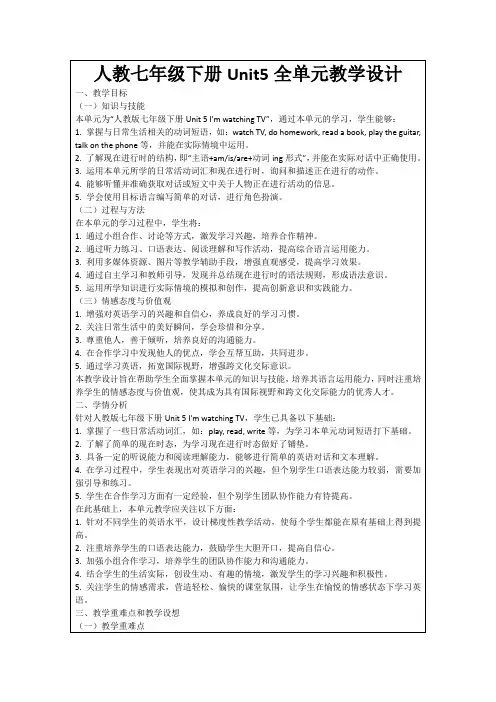
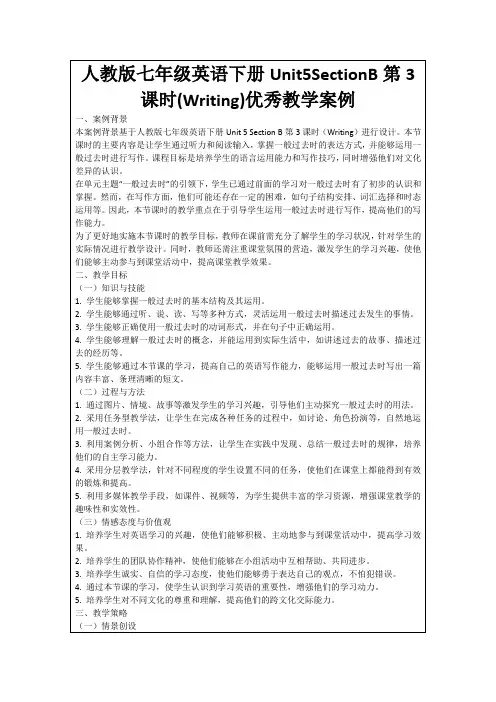
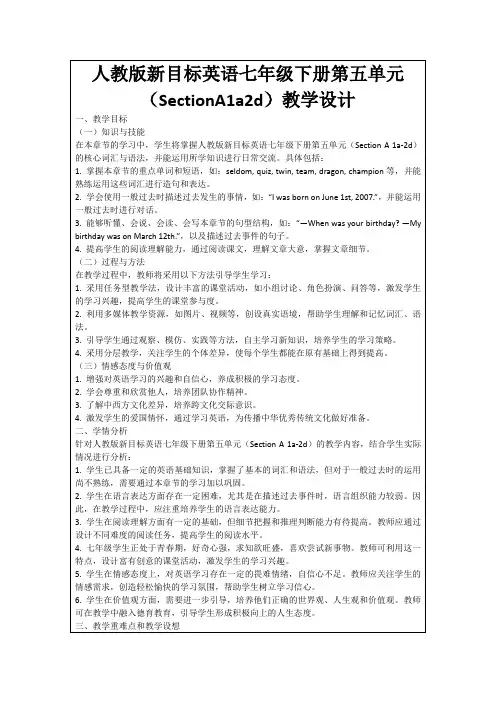
人教版新目标七年级英语下册 Unit 5 教学设计一. 教材分析人教版新目标七年级英语下册Unit 5主要围绕日常生活话题,通过学习本单元,学生能够掌握日常生活中的一些基本表达方式,提高他们的口语交际能力。
本单元的主要内容包括:询问和描述日常活动、表达喜好和意愿、谈论过去和将来的计划等。
本节课的主要目标是让学生能够熟练运用一般现在时进行日常交流。
二. 学情分析七年级的学生已经掌握了基本的英语语法和词汇,对日常生活中的常用表达有一定的了解。
但是,他们在口语表达和听力理解方面还存在一定的困难。
因此,在教学过程中,需要注重培养学生的口语交际能力和听力理解能力。
三. 教学目标1.能够熟练运用一般现在时进行日常交流。
2.能够听懂并正确回答关于日常活动的问题。
3.能够描述自己的喜好和意愿。
4.能够谈论过去和将来的计划。
四. 教学重难点1.一般现在时的运用。
2.日常英语表达的准确性。
3.听力理解的提高。
五. 教学方法采用交际法、任务型教学法和情境教学法。
通过设定真实的语境,让学生在实际交流中掌握语言知识,提高他们的口语交际能力和听力理解能力。
六. 教学准备1.教材:人教版新目标七年级英语下册。
2.教学多媒体课件。
3.教学卡片。
4.录音机和录音带。
七. 教学过程1.导入(5分钟)通过与学生谈论他们的日常活动,激发学生的学习兴趣,引导学生进入学习状态。
2.呈现(10分钟)利用多媒体课件和教学卡片,展示本节课的主要内容,让学生初步感知和理解。
3.操练(15分钟)通过小组活动和角色扮演,让学生在实际交流中运用所学知识,提高他们的口语交际能力。
4.巩固(10分钟)通过听力练习和口语交流,让学生进一步巩固所学知识,提高他们的听力理解能力。
5.拓展(10分钟)让学生谈论自己的喜好和意愿,以及过去和将来的计划,提高他们的语言运用能力。
6.小结(5分钟)对本节课的主要内容进行回顾和总结,让学生明确所学知识。
7.家庭作业(5分钟)布置作业:让学生运用一般现在时写一篇关于自己日常活动的短文。
Unit 5 Why do you like pandas?
写作技能训练单
班级:____________ 姓名:____________ 组名:____________
【学习目标】
以小组合作的形式,制作一张保护动物的海报
【目标语言】
a/the symbol of …; grow up to … meters; weigh up to … kilograms; kill… for …; there are ...
【过程与方法】
通过小组讨论、写作和展示等一系列的课堂活动,培养学生的合作精神
【情感态度价值观】
了解一些关于濒危动物的知识,培养保护动物的意识
【学习重点和难点】
目标语言的综合运用
【预习评价】
二、匹配信息。
(
P for ,
T for )
【多元评价】
1、完成单子情况
2、主动帮助同伴
3、主动展讲
4、主动补充与质疑
5、纪律情况。
Unit5 Why do you like pandas?Period 1 Section A(1a-2c)Teaching aims:1. Know the words about animals and their personalities.2. Enable the students to talk about and describe their favorite animals.3. Educate the students to love and protect animals.Key points:1. Master these words: zoo, animals, panda, tiger, elephant, koala, lion, giraffe, cute,beautiful, smart, lazy, scary, kind of, South Africa, Australia.2. Master the following sentence patterns:------ Why do you/don’t you like …?Why does /doesn’t he /she like …?Because they are …------ Where are … from?They are from …Teaching aids: a tape recorder, pictures, ppt.Teaching steps:Step One GreetingsSay Hello to the students.Step Two Lead-inPlay a short video for the students. What animals do you know?Step Three Presentation1. Teach new words with pictures.2. Present the following sentences with pictures.Why do you/don’t you like …?Because they are …Step Four ListeningPlay the recorder and ask students to do activity 1b.Step Five pair work.Show some pictures and a sample dialogue to the students, then ask them to make more conversations and act them out.A: Let’s see the lions.B: Why do you want to see them?A: Because they are interesting.cute interesting funsmart beautiful friendly shy…Step Six Work in groups. Ask and answerShow a sample dialogue to the students, then ask them to make more conversations and act them out.A:I like dogs. B:Why do you like dogs?A:Because they are cute and friendly.B: What animals does she like? Why does she like them?A:She likes panadas. Because they’re cuteStep 7 Listening1. Listen and complete 2a. Play the recorder twice, for the first time , students findout the animals they hear. Then they guess the description words and countries.Next, play the recorder for the second time and students to make sure theanswers.2. Listen and complete 2b.Step Seven Pair work1.Present a map of the world to teach new words and the new sentence pattern“Where are they from?”“They are from…”2. Show some pictures of animals and have students make conversations with thefollowing sentences:A: Let’s see…Do you like …? B:Yes, I do./ No, I don’t.A: Why do you/ don’t you like them? B: Because they are… .A: Where are they from? B: They are from… .3. Ask several pairs to show their conversations.Step Eight Survey1. Ask students to work in groups and do a survey.2. Fill in the chart about the survey .3. Ask students to do a report about their survey results.Step Nine Homework1. Make a list of the animals you know and try to describe each animal with a wordwe learnt in this class.2. Write an article about your favorite animals and describe their appearances, personalities, food, hobbies and where they are from.Period 2 Section A (1a-2c)Teaching aims:1. Know the words about animals and their personalities.2. Enable the students to talk about and describe their favorite animals.3. Educate the students to love and protect animals.Key points:1. Master these words: pet, leg, cat, sleep.2. Master the following sentence patterns:Why do you like pandas?Becau se they’re kind of interesting.Why does John like koalas?Because they’re very cute.Why don’t you like tigers?Why don’t you like tigers?Where are lions from?They’re from South Africa.Teaching procedures:Step 1: Review.1.Review the words: chant.2. Where are the animals from?Step 2 Work on 2d. Role-play.1.T: Some people like animals very much.They keep (=have养)an animal athome. We call the animals that we keep at home pets. (pet, cat,leg, sleep) T: What pets do people keep?2. Fast reading. Read the conversation and answer the questions.(1). What pet does Peter have?(2). What pet does Jenny’s mother have?3.Careful reading. Read again and answer the questions.(1). Does Peter like his dog?(2). What can the dog do?(3). Does Jenny like her mother’s pet? Why or Why not?4. Then Ss read the conversation in 2d5. Let some pairs role-play the conversation in 2d.Step 3 Grammar Focus.1.学生阅读Grammar Focus中的句子,然后做填空练习。
人教版七年级下册英语Unit 5大单元教学整体教学设计一. 教材分析人教版七年级下册英语Unit 5主要围绕“家庭成员”展开,通过介绍家庭成员的名称、职业和爱好等,让学生掌握一般现在时的表达方式。
教材通过丰富的图片、情景对话和任务型活动,激发学生的学习兴趣,培养学生运用英语进行交际的能力。
二. 学情分析七年级的学生已经掌握了基本的英语语法和词汇,具备一定的听说读写能力。
但部分学生对家庭成员的英文表达和用法还不够熟悉,需要在课堂上进行针对性训练。
此外,学生对英语学习的兴趣和动机有待进一步提高。
三. 教学目标1.知识目标:学生能够掌握家庭成员的英文表达,学会用一般现在时介绍家庭成员的名称、职业和爱好等。
2.能力目标:学生能够在日常生活中运用英语进行家庭成员的介绍,提高口语交际能力。
3.情感目标:学生能够培养对英语学习的兴趣,增进与同学之间的友谊。
四. 教学重难点1.重点:家庭成员的英文表达和一般现在时的运用。
2.难点:家庭成员词汇的拓展和一般现在时在不同情境下的运用。
五. 教学方法1.情境教学法:通过设定生活情境,让学生在实际语境中学习、运用英语。
2.任务型教学法:引导学生参与各种任务,提高学生的实践能力和合作意识。
3.游戏教学法:通过趣味游戏,激发学生的学习兴趣,巩固所学知识。
六. 教学准备1.教学课件:制作课件,包含图片、视频、任务型活动等。
2.教学道具:准备与家庭成员相关的实物道具,如家庭成员照片、角色卡片等。
3.教学资源:收集一些关于家庭成员的英文资料,如文章、歌曲等。
七. 教学过程1.导入(5分钟)利用趣味游戏“猜猜我是谁?”引导学生谈论家庭成员,激发学生的学习兴趣。
教师出示一些家庭成员的图片,让学生用中文进行介绍。
2.呈现(10分钟)教师展示Unit 5的课件,引导学生关注标题“家庭成员”。
通过展示教材中的图片和情景对话,让学生整体感知课文内容。
同时,教师用中文解释一般现在时的概念,为学生接下来的学习做好铺垫。
Unit5 Why do you like pandas?
写作指导课
北戴河区第三中学吴晓
一、教学内容与学生情况分析
本案例是笔者在北戴河区中小学英语教师写作观摩优质课上执教的公开课,内容为基于人教版2011新课标《英语》七年级下册Unit5 Why do you like pandas?引申出的写作内容。
要求学生根据提示内容,以北京动物园为题展开介绍。
、
学生通过第五单元的学习,已经掌握了表示描述动物的词语以及描述动物的基本句型,能够用英语谈论喜好的动物及原因,学生所积累的语言知识和语言技能为本单元写作奠定了基础。
笔者人教学校为农村中学,学生普遍存在基础较差、英语学习兴趣低等情况。
二、教学目标
知识与技能目标:运用描述性词语介绍动物,并说明喜好及原因。
过程与方法目标:通过小组合作法开展写作,采用先自学后指导的方法推进。
情感态度目标:引导学生树立爱护动物、保护动物的意识。
三、教学重点
根据第五单元所学内容和以往知识储备,完整撰写出一篇介绍动物园的文章。
四、教学难点
对文章结构完整度的把握,多种句型的运用以及对文章内容的升华。
五、教学方法
讲授法、讨论法、练习法、探究法。
六、教学过程
Step1: Pre-writing(第一阶段:写作准备)
上课伊始,幻灯片呈现一张动物园照片,唤醒学生记忆,引导学生复习本单元已学的表示动物的词语、句型,谈论喜好。
让全班每一位学生都得到发言机会,充分调动学生积极性,唤醒已学知识。
T:Welcome to the zoo.
What animals do you know?
Ss:_______
T: What animals do you like?
SS: I like____.
T: Why?
Ss: Because ______.
T: Do you know where they are from?
Ss: There’re from__________
T:Make a dialogue using the sentences you just mentioned.(幻灯片呈现对话涉及的句型)
【设计意图】
写作准备作为一节课的预热阶段是定基调和开启思维的关键环节。
通过动物园的图片让学生迅速进入写作内容相关情境,自然引出本节课的写作主题——动物。
同时通过生生问答让每一个学生参与到课堂之中,唤醒知识储备;小组合作演绎对话进一步激活学生的思维,激发学生的兴趣。
Step 2: Task (第二阶段:呈现写作任务)
T:There are so many lovely animals in the zoo. Why not writing a composition to introduce the zoo. Today let’s write an article about the zoo. The points have given to you.
以幻灯片的形式将本节课的写作要求呈现出来。
“北京动物园每天都会来很多人,小朋友们最喜欢这个地方。
动物园里有许多动物。
有来自非洲的大象、害羞的熊猫、可怕的老虎、有趣的猴子和其他动物。
这里一定有你最喜爱的动物。
请参考提示内容,请以Beijing Zoo为题介绍一下北京动物园,不少于60个单词。
”
【设计意图】
基于学生学情特点,鼓励学生在没有任何限制的情况下敢于下笔,改变传统先呈现、讲授句型再下笔的模式,最大限度为学生创设自由的写作环境。
T: Exchange your articles in groups. Score them according to the evaluation standards.
幻灯呈现评价标准。
【设计意图】以小组合作方式互评作品,进一步唤醒思维,同时培养学生评价能力。
Step3: Have a discussion(小组讨论)
T: Look at the screen and think about two questions.
以幻灯片呈现
1. How many parts can we divide the article into?
这篇文章可以分为几部分来书写?
2. What can be written for each part?
每部分可以写哪些内容?
引导学生展开小组讨论。
【设计意图】小组讨论培养学生独立思维能力以及合作意识,通过讨论理清文章写作的思路,在讨论中实现思维碰撞,培养锻炼学生辩证思维。
T:What’s your opinion? Who wants to answer the question? 鼓励学生各抒己见,之后对学生答案进行归纳总结。
用幻灯片形式呈现。
学生分组针对文章不同部分撰写句子,展开组内讨论。
分组上前展示各部分写出的好词好句,教师在其中挑选部分在板书中呈现。
【设计意图】在对学生想法归纳总结梳理文章结构后,鼓励学生运用知识储备有针对性的分部分撰写句子,组内分享实现资源共享。
教师板书的呈现一方面展现教师基本功另一方面对重点句型进行再次点
评,指出学生撰写过程中的小错误。
Step4:Polish the writing(润色文章)
根据总结出的好词好句润色自己的文章。
Step5:Group Work
T: Exchange your articles again in your groups to see if you have made some advances?
对照评分标准再次组内互评,看看是不是每个人都有所进步?幻灯片再次呈现评分标准。
每位学生的分数相较之前都有所提高,幻灯呈现:
A Little progress a day makes you a big success.
每天进步一点点,成功离你不会远!
【设计意图】
在对文章进行修饰之后,与最初文章相对比,让学生彼此之间看到进步,看到这节课的收获,提升学生的自信心。
幻灯片最后呈现的句子要求学生多次齐读,对学生进行德育渗透。
Step6:Show Time(佳作展示)
让学生以组为单位,推选本组佳作,向全班推荐。
被推荐的作品由学生在站台上向全班展示,教师对文章进行点评。
【设计意图】
通过学生推荐进一步培养学生自主学习能力,佳作赏析
Step7:Thinking 思考
T: Looking at these pictures and then tells me what your feeling is?
幻灯呈现动物被伤害的图片,学生自由说出感想。
【设计意图】实现本课情感态度目标,树立爱护动物、保护动物意识。
Step 8:Homework
【设计意图】巩固本课知识。
【课后反思】本节课打破传统写作课先呈现知识再写的模式,让学生在不设限的情况下敢于动笔,是基于对农村学生英语学习情况了解的基础上作出的大胆尝试,旨在鼓励每一个学生都愿意尝试去写。
本课环节层层递进,环环相扣,目标明确,层次分明,学生参与度高。
而且德育渗透和情感态度目标达成效果好。
教师对课堂节奏把控得当,多媒体运用合理。
本课有两个环节可以在今后的教学中稍作改进,一是导入部分和文章要求部分可以考虑使用学生熟悉的当地动物园照片,让学生更有代入感。
二是在佳作赏析环节,教师可以尝试完全放手,让学生进行点评。